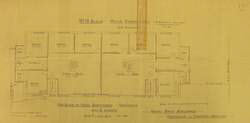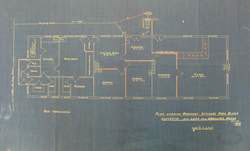Abandoned Communities ..... Teesport
By 1920 the submarine base had been de-commissioned. The iron and steel company Bolckow Vaughan decided to convert the buildings into a small community that retained the name Teesport. Presumably they intended to use the buildings as staff accommodation. Joan Outhwaite has looked at the Bolckow Vaughan minutes for 16 July 1921. It was reported that £8400 had already been spent on constructing 23 dwellings, and it was decided that a further £3700 should be spent on the completion of another 15 houses.
The conversion plans can be seen at Teesside Archives. The general layout plan is reproduced on the left. Two other plans appear below it. One shows how 13 blocks, containing men's dormitories, were to be converted into two dwellings each. The other shows how the warrant officers' mess block would be converted into a shop and a dwelling.
Most of the houses had three fairly small bedrooms, some had four bedrooms. They had a large living room, with a cooking range in the centre of the room and a pantry in one corner. There was a scullery next to the pantry, and on either side of the front door a water closet and a space for coal storage. The water supply pipes and the drains appear on the plans, but there is no indication of electricity or mains gas.
From other evidence we know that a mission room was created at Teesport, presumably through the conversion of another building.
At Teesside Archives you can also see a plan for a small school at Teesport. The school, comprising just two rooms, opened on 18 April 1932, taking children aged 5 to 8. One room was the classroom, the other an indoor playground. The teacher was Mabel Todd, who remained in the post until the school closed in November 1936.
Go to the Teesport Tales website to read extracts from the school logbook and the personal records of Mabel Todd.
Electoral registers for several of the years in the 1920s and 1930s can also be found at the Teesside Archives. Teesport formed part of the Grangetown ward within the Eston UDC. In 1930, for example, there were voters in all but two of the 38 houses, numbers 3 and 5 being vacant. The total number of voters was 82, suggesting a population, once you include people under 21, of about 120 to 130.
Most houses in 1930 had at least two voters. Only at 16, where Mary Scott lived, was a single voter registered. On the whole, just a couple with the same surname were registered at each house, but at both numbers 18 and 19 there were two couples. At seven houses there was an additional single voter. In some cases that person had the same surname as the couple living at the same address. For example, George Windross junior lived at number 37 with George Windross and Kathleen Windross. At number 20 it is possible that Liza Davies was related to the couple living there, Edith Eliza Vaughan and Philip James Vaughan, either as their married daughter or as the mother of Edith Eliza Vaughan.
Percival Jones and Sarah Jones were living at number 13. Patrick Brannan was living with them, and Alan Broadfoot has told me that he was Sarah’s brother. Alan has added that Percival and Sarah had two daughters, including Naomi, aged 8 in 1930.
By 1936 there were just 37 voters, registered at only 15 houses. In five houses the same couple were living at the address as in 1930. For instance, Laura and Walter Bone were still at number 22, and Elizabeth and Sydney Jary were still next door to them at number 23. Elizabeth Eleanor Edwards and Robert Evan Edwards had moved from 8 to 10. George Windross junior no longer features at 37, but instead William Herbert Windross has moved there from number 31.
In the following year, 1937, only two voters remained, Ronald and Jeanette Buchan. In 1930 Ronald Buchan was living at number 12 with two other men of the same surname, but by 1936 Jeanette had joined him at number 5. They are both still registered in 1938 and 1939, and must have continued to live at Teesport for at least a few years longer than anyone else. During World War II electoral registers were not compiled. By 1945 the Buchans had departed, though six NAAFI staff were registered at Teesport in that year.
Teesport was effectively depopulated by 1937, when Ronald and Jeanette Buchan were the only registered voters. However, as you can see on the photo on the next page, some of the houses still existed in 1947, and Joan Outhwaite has discovered that some of them must have been occupied in 1950. The electoral register for that year includes nine couples, most of them living in dwellings called “The Hutments”. They may have been accommodated at Teesport on a temporary basis as the local authority tried to deal with the housing shortage that followed World War II.
Eric Smith has confirmed that some of the houses in Teesport were occupied again around 1950. He recalls aged about five walking to visit his aunt Frances Hurst and
The conversion plans can be seen at Teesside Archives. The general layout plan is reproduced on the left. Two other plans appear below it. One shows how 13 blocks, containing men's dormitories, were to be converted into two dwellings each. The other shows how the warrant officers' mess block would be converted into a shop and a dwelling.
Most of the houses had three fairly small bedrooms, some had four bedrooms. They had a large living room, with a cooking range in the centre of the room and a pantry in one corner. There was a scullery next to the pantry, and on either side of the front door a water closet and a space for coal storage. The water supply pipes and the drains appear on the plans, but there is no indication of electricity or mains gas.
From other evidence we know that a mission room was created at Teesport, presumably through the conversion of another building.
At Teesside Archives you can also see a plan for a small school at Teesport. The school, comprising just two rooms, opened on 18 April 1932, taking children aged 5 to 8. One room was the classroom, the other an indoor playground. The teacher was Mabel Todd, who remained in the post until the school closed in November 1936.
Go to the Teesport Tales website to read extracts from the school logbook and the personal records of Mabel Todd.
Electoral registers for several of the years in the 1920s and 1930s can also be found at the Teesside Archives. Teesport formed part of the Grangetown ward within the Eston UDC. In 1930, for example, there were voters in all but two of the 38 houses, numbers 3 and 5 being vacant. The total number of voters was 82, suggesting a population, once you include people under 21, of about 120 to 130.
Most houses in 1930 had at least two voters. Only at 16, where Mary Scott lived, was a single voter registered. On the whole, just a couple with the same surname were registered at each house, but at both numbers 18 and 19 there were two couples. At seven houses there was an additional single voter. In some cases that person had the same surname as the couple living at the same address. For example, George Windross junior lived at number 37 with George Windross and Kathleen Windross. At number 20 it is possible that Liza Davies was related to the couple living there, Edith Eliza Vaughan and Philip James Vaughan, either as their married daughter or as the mother of Edith Eliza Vaughan.
Percival Jones and Sarah Jones were living at number 13. Patrick Brannan was living with them, and Alan Broadfoot has told me that he was Sarah’s brother. Alan has added that Percival and Sarah had two daughters, including Naomi, aged 8 in 1930.
By 1936 there were just 37 voters, registered at only 15 houses. In five houses the same couple were living at the address as in 1930. For instance, Laura and Walter Bone were still at number 22, and Elizabeth and Sydney Jary were still next door to them at number 23. Elizabeth Eleanor Edwards and Robert Evan Edwards had moved from 8 to 10. George Windross junior no longer features at 37, but instead William Herbert Windross has moved there from number 31.
In the following year, 1937, only two voters remained, Ronald and Jeanette Buchan. In 1930 Ronald Buchan was living at number 12 with two other men of the same surname, but by 1936 Jeanette had joined him at number 5. They are both still registered in 1938 and 1939, and must have continued to live at Teesport for at least a few years longer than anyone else. During World War II electoral registers were not compiled. By 1945 the Buchans had departed, though six NAAFI staff were registered at Teesport in that year.
Teesport was effectively depopulated by 1937, when Ronald and Jeanette Buchan were the only registered voters. However, as you can see on the photo on the next page, some of the houses still existed in 1947, and Joan Outhwaite has discovered that some of them must have been occupied in 1950. The electoral register for that year includes nine couples, most of them living in dwellings called “The Hutments”. They may have been accommodated at Teesport on a temporary basis as the local authority tried to deal with the housing shortage that followed World War II.
Eric Smith has confirmed that some of the houses in Teesport were occupied again around 1950. He recalls aged about five walking to visit his aunt Frances Hurst and
Two
The general plan for converting the submarine base into houses.
The plan for converting each of the men’s dormitories
The plan for converting the Warrant Officers’ Mess


